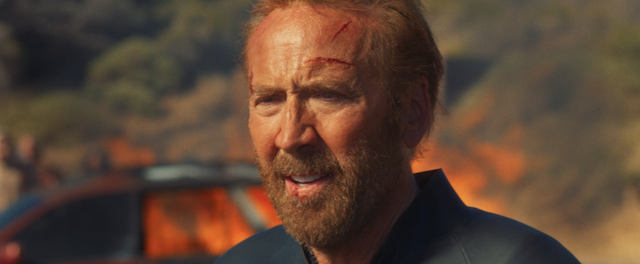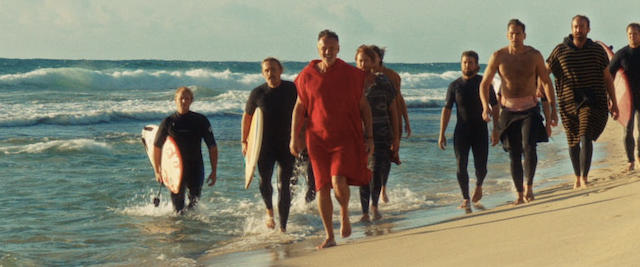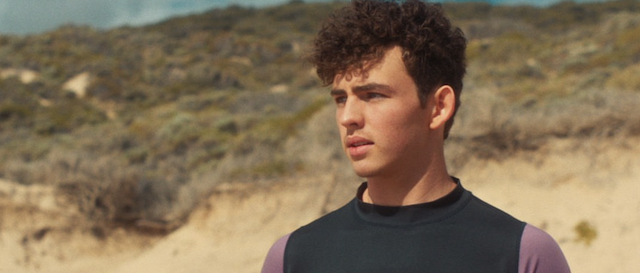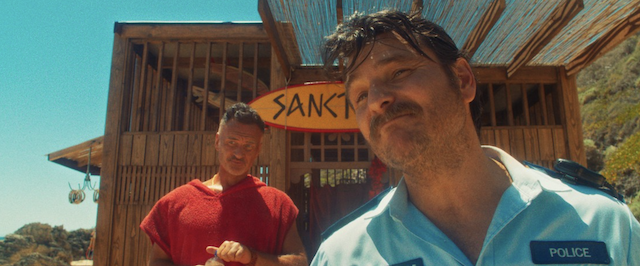
©Courtesy of Lionsgate
No actor has mastered crafting his characters’ descent into mental and physical disarray quite like Nicolas Cage. He has seen a bit of a resurgence in choosing realistic, but at times unhinged, acclaimed roles during the first half of the current decade. His latest film, the psychological thriller The Surfer, proves to be no exception.
Cage also served as a producer on the feature, which was directed by fellow genre veteran, Irish filmmaker Lorcan Finnegan (Nocebo, Vivarium). The helmer worked closely with fellow Irish filmmaker, writer Thomas Martin, to craft the project’s story. The movie was in part inspired by the short stories of Australian writer Robert Drewe, as well as John Cheever’s 1964 short story, The Swimmer, and its screen adaptation starring Burt Lancaster.
The Surfer follows the titular protagonist (Cage) as he returns to the idyllic Luna Beach in Australia, where he spent his childhood, to reunite with his teenage son (Finn Little). After moving to California as an adult, the father returned to the country of his youth to buy the house he lived in as a child, in an attempt to impress his son during his impending divorce.

©Courtesy of Lionsgate
When the duo arrive on the beach, they soon encounter a conflict with some of the menacing locals. While the beach is technically public, a menacing surfer gang, known as the Bay Boys, has claimed it as their own. The surfer and his son are warned by one of the gang members, Scally (Julian McMahon), that their mantra is “don’t live here, don’t surf here.”
Even as he receives threats from the surfer gang, the surfer is determined to stand his ground. He remains in the beach’s parking lot and its surrounding area with a homeless man known as The Bum (Nic Cassim). Humiliated and angry as the gang steals his status-defining belongings and then his dignity, The Surfer is drawn into a conflict that pushes him to his breaking point.
The Surfer conjures a dreamy sense of disorientation that ponders the protagonist’s reality through an aesthetic that’s reminiscent of the 1970s Australian New Wave genre. Psychedelic camera angles and slow zooms from the drama’s cinematographer, Radek Ladczuk, enthralling capture The Surfer’s growing paranoia.
Frequent zooms into the main character’s twitchy eyes further highlight his unraveling sanity as he tries to prove his worth and right to be on the beach to his son and the gang. Cage uses his signature absurdist sense of humor as his character desperately tries to hold onto an idyllic dream that no longer suits him. Combined with the increasing desperation that the Oscar-winning actor also injected into his performance, it becomes clear that the protagonist is unable to maintain a grip on reality, including whether he’s as successful and smart as he believes.

©Courtesy of Lionsgate
Cage’s performance helped Finnegan and Martin achieve their goal of making a film that feels like a peculiar, fantastical dream. The main character’s effort to reconnect with his son and prove his determination to once again live as a local to the Bay Boys makes The Surfer more than just a gnarly beach film. The actor’s portrayal of the protagonist’s psychedelic struggles with materialism, sense of belonging and repressed memory also effortlessly highlight the filmmakers’ exploration into the psychological tailspin of a man struggling with his identity.
As Finnegan has shared about his experience working with Martin on The Surfer, the feature is also so realistically gripping because the story is also based in part on a violent incident the latter witnessed on a surf beach. The scribe saw two surfers get into a vicious fight over the right to ride the waves on a beach near Sydney.
As a result, the writer was inspired to pen the script. Overall, the movie expertly explores the causes and effects of extreme territorial behavior, which has become prevalent in surfing communities around the world.
Surfers’ increased desire to protect their local beaches in increasingly territorial ways was blended with Martin’s relationship with his father, and how men overall can become disconnect from their families, communities and themselves. Cage’s character represents not only surfers who feel deeply connected with their local beaches, but also fathers who are fighting to bridge the gap of separation with their sons.
While Finnegan and Martin both hail from Ireland, they chose to shoot The Surfer on a remote beach and car park in Yallingup, Western Australia. With the drama largely taking place outside at the beach, the film’s production designer, Emma Fletcher, crafted a unique atmosphere that represents the protagonist’s alluring and unsettling nature.
Inspired in part men who wish to reconnect with their families and communities, but are unable to in part because of extreme territorial behavior, The Surfer conjures a dreamy sense of disorientation as it ponders the eponymous character’s reality. With the aid of its captivating visual aesthetic, as captured by Ladczuk’s cinematography and Fletcher’s production design, the thriller perfectly highlights Cage’s brilliant performance. The movie truly thrives on the protagonist trying to come to terms with his family, community and most importantly, himself.

Grade: A-
If you liked the film, leave your comment below!
Check out more of Karen Benardello’s articles.
The Surfer made its North American premiere in the Festival Favorite section at the 2025 SXSW Film and TV Festival. Roadside Attractions will release the movie in U.S. theaters on May 2, 2025.
Here’s the trailer of the film.

